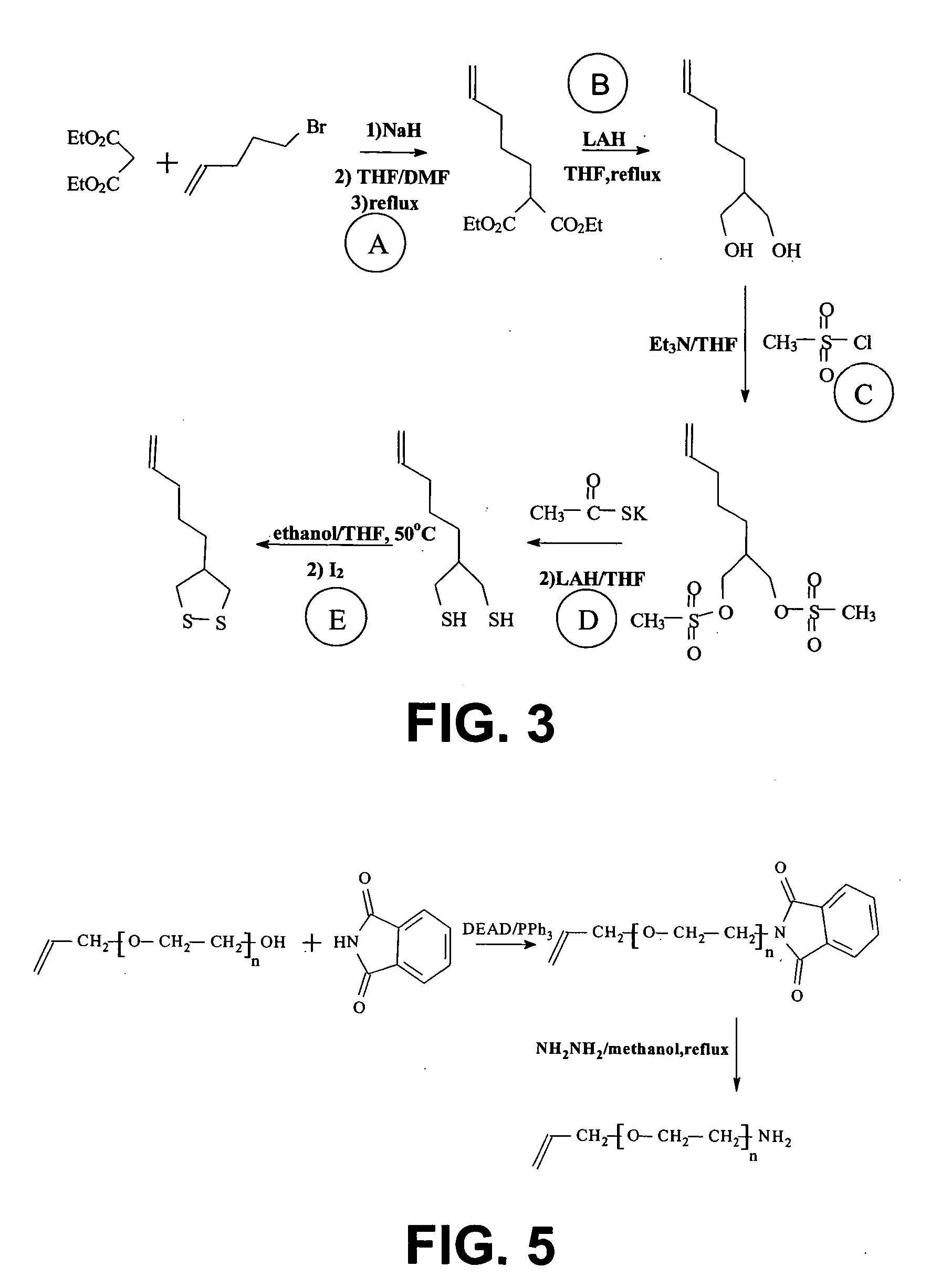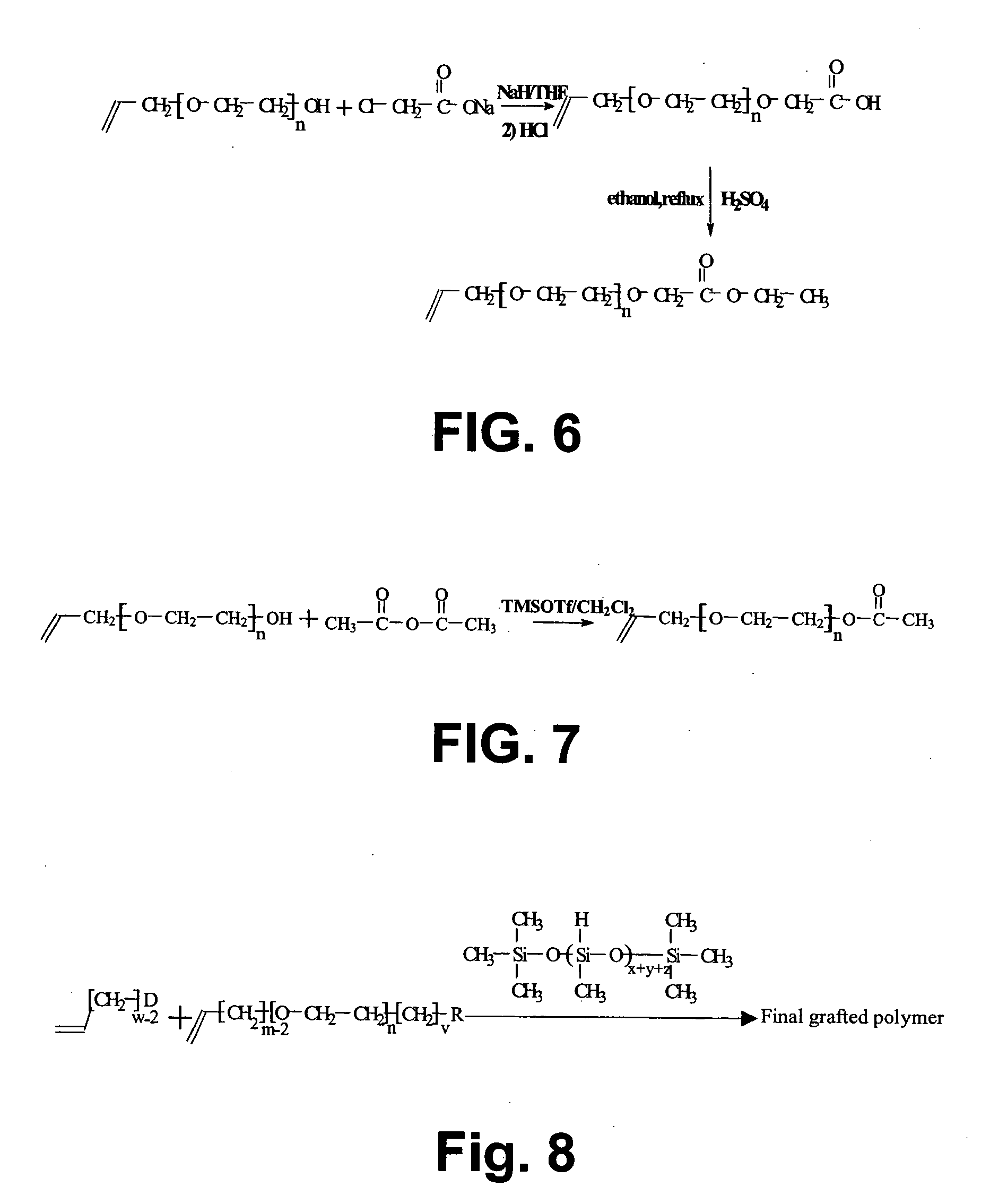Selfassembled grafted polymeric layer for use in biosensor technology
a biosensor and polymeric layer technology, applied in the field of water soluble functional peggrafted polysiloxane polymer, can solve the problems of limited robustness, limited application of cell-based biosensors to alkane thiol sams, and limited application of alkane thiol sams
- Summary
- Abstract
- Description
- Claims
- Application Information
AI Technical Summary
Benefits of technology
Problems solved by technology
Method used
Image
Examples
example 1
The Synthesis of 11 -Ethyldithiol-1 -undecene
[0119] A schematic illustration of the synthesis of 11-Ethyidithiol-1-undecene is given in FIG. 2.
[0120] Method: 2.33g 11-Bromo-1-undecene (Fluka) in 12 ml methanol was charged into a two-necked flask with condenser. 1 ml water was slowly added. Then the reaction solution was heated and refluxed. 3.102 g sodium thiosulphate pentahydrate (Na2S2O3.5H2O, Sigma) in 3 ml water was added slowly over 40 minutes. Reflux was maintained for another 4 hours. The reaction was then cooled down and the solvent is removed by rotary evaporation. Water was added to make a final volume of about 12 ml. The aqueous solution was extracted twice with hexane and the aqueous phase was thereafter collected. The collected aqueous solution was cooled down to 0° C. and 1.052 g sodium ethanethiolate (C2H5SNa, Fluka) dissolved in 1.3 ml water was added quickly. Next, 2 ml saline was added. After 10 minutes, the temperature was raised up to 5° C. The resulting soluti...
example 2
The Synthesis of 4-pentenyl-1,2-dithiolane
[0122] A schematic illustration of the synthesis of 4-pentenyl-1,2-dithiolane is given in FIG. 3.
[0123] Method: [0124] 1) The preparation of diethyl 2-pentenylmalonate (step A in FIG. 3): A solution of NaH (6.00 g, 150 mmol) in 250 ml dry tetrahydrofuran (THF) and 75 ml dimethyl formamide (DMF) was prepared at 0° C. in an argon atmosphere. To this solution, diethyl malonate (24.9 g, 150 mmol) was added slowly. The mixture was stirred for 15 minutes at room temperature. Then, 5-bromo-pentene (7.40 g, 50 mmol) was added and the mixture was heated up to reflux for 2 hours. The reaction mixture was concentrated by rotary evaporation and the resulting oil was suspended in 100 ml water. The mixture was first extracted twice with pentane and then once with a 1:1 mixture of pentane / diethyl ether. The organic layer was collected and washed by water three times and then dried over MgSO4. Then, it was filtrated and the solvent was removed by rotary e...
example 3
The Synthesis of 4-pentenyl 5-(1,2-dithiolan-3-yl)pentanoate
[0129] A schematic illustration of the synthesis of 4-pentenyl 5-(1,2-dithiolan-3-yl)pentanoate is given in FIG. 4.
[0130] Method: 5-(1,2-dithiolan-3-yl)pentanoic acid (1.03 g, 5 mmol) and 4-pentenyl-1-ol (0.52 g, 6 mmol) were added into 50 ml THF and then 34 drops of concentrated H2SO4 were added. The mixture was heated to reflux for 12 hours. After cooling down to room temperature, a saturated NaHCO3 solution was added to adjust the pH to 7. Then the mixture was filtrated and the solvent was removed. The concentrated product was dissolved in ethyl acetate and washed by water twice and brine once. The organic phase was collected and dried over MgSO4. Then it was filtrated and the solvent was removed to get the crude product. The product was then purified by chromatography on silica gel with hexane as an eluent.
Step 2:
[0131] A second step in the synthesis of the water soluble functional PEG grafted polysiloxane polymer ...
PUM
| Property | Measurement | Unit |
|---|---|---|
| volume | aaaaa | aaaaa |
| temperature | aaaaa | aaaaa |
| pH | aaaaa | aaaaa |
Abstract
Description
Claims
Application Information
 Login to View More
Login to View More - R&D
- Intellectual Property
- Life Sciences
- Materials
- Tech Scout
- Unparalleled Data Quality
- Higher Quality Content
- 60% Fewer Hallucinations
Browse by: Latest US Patents, China's latest patents, Technical Efficacy Thesaurus, Application Domain, Technology Topic, Popular Technical Reports.
© 2025 PatSnap. All rights reserved.Legal|Privacy policy|Modern Slavery Act Transparency Statement|Sitemap|About US| Contact US: help@patsnap.com



